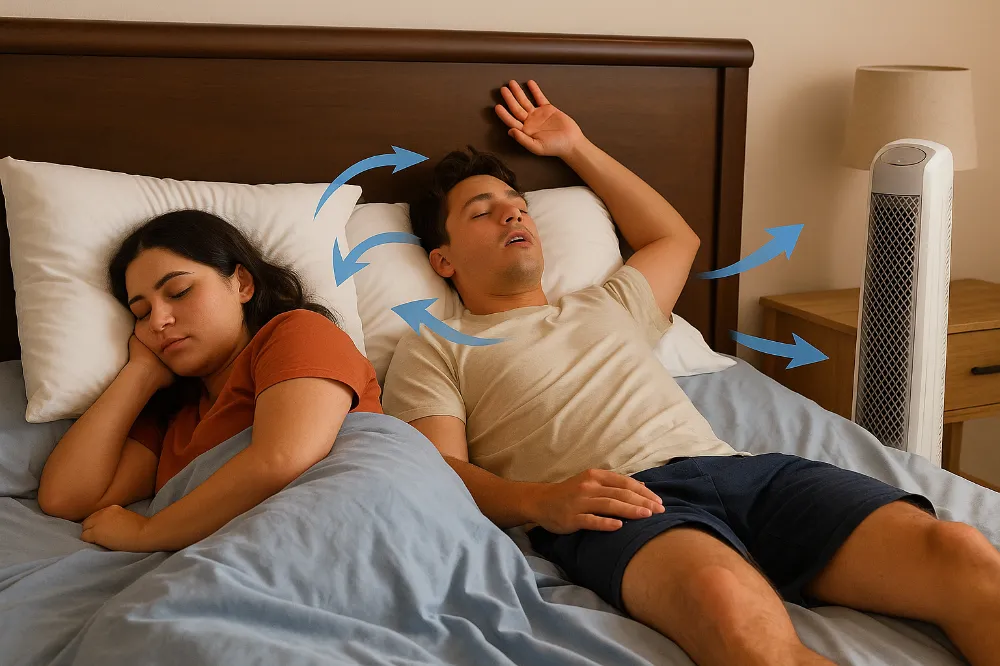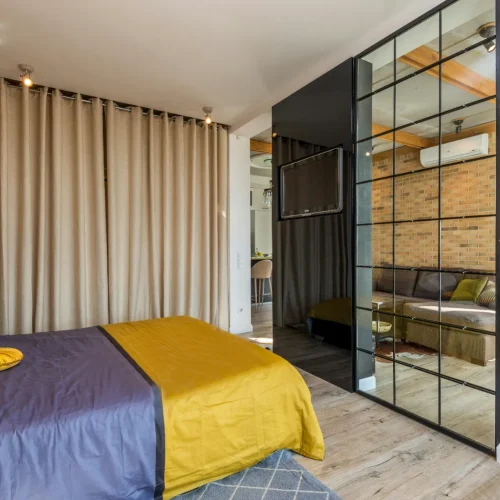
Sharing a bed with someone you love should feel comforting and warm, but when one person moves like they’re fighting dragons in their sleep, the entire mattress becomes a trampoline you never asked for. I used to think motion transfer was normal just part of being in a relationship but after years of being jostled awake, stealing covers for survival, or silently plotting a mid-night mattress escape, I realized that sleep doesn’t have to be chaotic. The real breakthrough happened when I stopped blaming the people in the bed and started looking at the bed itself, the materials, the setup, and all the little habits that turn a shared sleep space into a stable, peaceful one. What follows is the journey that saved our sleep, one discovery at a time.
Why Partners Disturb Each Other: The Real Reason Behind Motion Transfer
For the longest time, I thought my partner simply moved too much, but the real cause of disturbance is usually the sleep system, not the person. Motion transfer happens because the mattress, foundation, frame, and bedding all work together like a chain reaction if one part absorbs motion poorly, the entire bed broadcasts movement from one sleeper to the other. Even the height, weight, and sleep personality of each partner play a role, because someone who sleeps curled up and still affects the bed completely differently from someone who flops, rolls, or rotates like a rotisserie chicken. Once I understood that motion comes from multiple layers material, stability, bedding grip, and body habits it became easier to isolate what needed to change.
The Mattress Matters More Than Anything Else (But Not How You Think)
I used to assume that any “firm” mattress must automatically reduce motion, but firmness alone means nothing if the internal materials aren’t designed to absorb movement. Memory foam has been the most reliable motion-reducing option in my experience because it hugs your body and dampens energy before it spreads. Natural latex surprised me by being just as effective, only with a slightly springier feel that doesn’t trap heat as much. Modern hybrid mattresses can also be excellent as long as they use individually pocketed coils instead of interconnected springs, because pocketing prevents movement from rippling across the entire bed. These internal materials make or break motion transfer, and the moment we switched away from old-school coils, night disturbances dropped dramatically.
When a Mattress Topper Makes a Bigger Difference Than Expected
A quality mattress topper felt like a small upgrade at first, but it quickly became one of the most powerful tools in reducing motion transfer. A thick, dense topper—especially memory foam or latex—absorbs movement before it ever reaches the deeper layers of the mattress. It acts almost like a cushion barrier between the two sleepers, keeping motion contained even when the mattress underneath isn’t perfect. What surprised me most was how much calmer the entire sleep surface felt once we added a topper; the bed felt heavier, quieter, and more stable. It wasn’t just more comfortable—it genuinely stopped those little midnight tremors I used to wake up from.
The Frame and Foundation: The Hidden Culprit Nobody Talks About
The biggest plot twist in my sleep journey was discovering that our bed frame was actually causing more disturbance than the mattress. A shaky frame, loose screws, flexible slats, or hollow legs can amplify even the tiniest movements like an echo chamber. I learned this the hard way when tightening a few bolts reduced the wobble instantly, and switching to a frame with center support legs created stability I didn’t even know we were missing. A solid platform frame or a sturdy wood base makes the bed feel anchored, while weak or lightweight frames turn the mattress into a drum that vibrates with every toss. Fixing the foundation was one of the fastest, cheapest wins we ever had.
Split Bases, Split Mattresses, and the Magic of Dividing the Sleep Surface
I resisted the idea of a split mattress for years because I worried it would feel “separate,” but the day we switched to a split king setup, everything changed for the better. By dividing the sleep surface into two independent halves—either through two twin XL mattresses, a split base, or a split adjustable platform—each partner gets their own stability zone, which prevents movement from traveling across the bed. The beauty of this setup is that you still get the emotional closeness of a shared bed while physically isolating motion at its source. And visually, with one duvet and one headboard, no one can tell the bed is split at all. It’s the best-kept secret of peaceful couple sleep.
Bedding Choices That Keep the Bed Grounded Instead of Sliding Around
I never expected bedding to play a role in motion transfer until I realized that lightweight sheets and slippery comforters were shifting the entire sleep surface with every move. Once we switched to deeper-pocketed fitted sheets, textured duvet covers, and a heavier top layer, everything stopped sliding around like a skating rink. Using bedding with more grip and weight keeps the mattress topper, sheets, and comforter from yanking across the bed when one person adjusts their position. In some cases, even switching to separate blankets eliminated that tug-of-war that often causes movement in the first place. Small textile choices made the entire bed feel calmer and more secure.
Sleep Personalities: The Part No One Warned Me About

Every person has a unique “sleep personality,” and understanding this changed everything about how we approached motion management. Some people move constantly because of pressure issues, some flip to regulate temperature, and some drift into the middle of the bed like magnets. Once I understood why each of us moved whether from discomfort, heat, or habit it became easier to tailor the sleep environment around those tendencies. My partner benefitted from a body pillow that stabilized their posture, and I benefitted from a cooling sheet set that prevented overheating. When you support your natural sleep style, you automatically move less, which reduces motion transfer more than you’d expect.
Motion-Reducing Accessories That Actually Help
Over time, I’ve tested more sleep accessories than I care to admit, but a few of them actually made a real difference in damping movement. Weighted blankets provide gentle pressure that keeps restlessness in check, almost like the adult version of being swaddled. Body pillows help restless sleepers stay anchored instead of rolling across the mattress, and mattress encasements keep multiple layers from sliding independently. Even simple additions like non-slip pads under the mattress stopped the whole bed from shifting when one of us sat down or got up. These accessories don’t replace a good mattress, but they elevate the whole system in a way that noticeably reduces movement.
Temperature and Movement: The Connection I Didn’t Believe at First
One of the most surprising discoveries was realizing how much heat contributes to restlessness. When someone gets warm at night, they automatically start kicking, turning, adjusting, and searching for a cooler spot. That constant repositioning transfers motion across the bed. Cooling the bedroom by just a few degrees, switching to breathable sheets, or adding a cooling topper helped both of us stay comfortable enough to sleep still. Once our bodies were no longer overheating, the overall movement dropped dramatically. It turns out temperature isn’t just about comfort it directly affects how much you toss and turn.
Adjustable Bases: Not Just for Snoring or Back Pain
I used to assume adjustable bases were only for medical needs, but adding one became one of the smartest sleep decisions we ever made. Even slight elevation in the head or legs reduces pressure on joints and helps your body settle faster, which naturally cuts down on nighttime movement. When the spine feels supported, the body doesn’t need to change positions as frequently, and when each person can fine-tune their ideal angle, motion transfer drops even more. And if you choose a split adjustable base, you not only personalize comfort but also eliminate the mechanical spread of motion between partners.
Weight Distribution: Why Heavier Beds Feel Calmer
I never expected weight to matter until I noticed that lighter mattresses tended to shift or bounce more easily with movement. Heavier mattresses especially latex or thick hybrids stay grounded and stable, absorbing motion instead of transmitting it. Even adding a dense topper or heavier bedding made the surface feel more planted. When a mattress feels anchored, it is far less reactive to movement, and the sleep experience becomes noticeably smoother. The goal isn’t to make the bed feel like a brick it’s simply to make sure the mattress itself doesn’t wiggle every time someone breathes.
Daily Sleep Routine: The Subtle Fix That Reduces Motion Without Buying Anything
One of the easiest and most overlooked ways to reduce motion is simply syncing sleep routines so both partners are winding down around the same time. Most people move the most in the first 30 minutes of falling asleep or during early morning restlessness. When one person is already asleep and the other is adjusting, scrolling, or getting settled, the difference in activity becomes obvious. Aligning bedtime rhythms even loosely reduces the overlap between one person’s stillness and the other’s movement. A shared wind-down routine, dim lighting, or a mutually agreed “phones off” moment created a smoother transition for us, and the bed became much quieter because of it.

Final Thoughts: You Deserve a Bed That Doesn’t Shake You Awake
After years of trying to ignore the problem, I learned that motion transfer isn’t about fault or blame it’s simply about how the sleep environment is built. Once we started making intentional changes, our bed became calmer, quieter, and more comfortable than I ever thought possible. Whether you start with a topper, switch to a split foundation, adjust temperature, or completely reinvent your setup, each change adds up to better sleep for both of you. And honestly, peaceful sleep makes everything in the relationship feel easier. When your nights are calm, your days feel lighter. You deserve a bed that doesn’t fight you and once you create one, you’ll wonder how you ever lived without it.
FAQs
Motion transfer happens when movement travels through the mattress, bed frame, or bedding, making one partner feel the other’s movements.
Memory foam and latex mattresses absorb movement extremely well, while hybrids with pocketed coils also perform strongly.
Yes. A dense memory foam or latex topper can greatly reduce movement by adding a shock-absorbing layer on top of the mattress.
Absolutely. A weak or wobbly frame amplifies movement. A solid wood frame, platform base, or one with center support reduces motion.
Yes. A split king isolates movement by dividing the sleep surface, so each partner’s motions stay on their own side.
They can. Adjustable bases allow each person to find a comfortable angle, reducing the need to toss or reposition during the night.
Heavier duvets, deep-pocket sheets, and non-slip mattress pads keep bedding secure, minimizing shifting and tugging.
Yes. Overheating leads to restlessness. Cooler room temps and breathable bedding help reduce nighttime movement.
For many couples, yes. Separate blankets can stop tugging, shifting, and pulling that cause disturbance.
Adding a dense memory foam topper, tightening the bed frame, or using a non-slip pad under the mattress are inexpensive yet highly effective.












